Performance Evaluation of Electrically Driven Agricultural Implements Powered by an External Generator
Abstract
1. Introduction
2. Materials and Methods
2.1. e-Source Specification
2.2. Implement Specifications
2.2.1. Sprayers
2.2.2. Mulchers
2.3. Sensors and Acquisition System
- e-Source electric current output (): measured with a current sensor (HAT 200-S, LEM GmbH, Europe) installed inside the e-Source case, on the electric current output cable (Figure 6a).
- Tractor front PTO torque () and speed (): measured with a custom-made sensored cardan shaft (Bondioli and Pavesi S.p.A, Italy) placed between the tractor front PTO and the e-Source (Figure 6b).
- Tractor rear PTO torque () and speed (): measured with a Datum Electronics Series 420 torquemeter (Datum Electronics, UK) placed between the tractor rear PTO and the cardan shaft connected to the implements (Figure 6c).
- The engine power ( was calculated with the Equation (1):
- The e-Source input power ( coming from front PTO was calculated with the Equation (2):
- The power absorbed by the PTO driven implements was calculated with Equation (3):
- The power absorbed by the electrified implements was calculated with Equation (4):
2.4. Experimental Tests
2.4.1. Implement Hitching Time
2.4.2. Noise Tests
2.4.3. Field Tests
2.5. Data Analysis
- The field capacity ( was calculated with Equation (6):where is the implement width for the mulchers or the distance between rows for the sprayers
- The fuel consumption per hectare ( was calculated with Equation (7):
- The CO2 emission per hectare () was calculated with Equation (8):where = 2.65 was based on the calorific value of diesel with a density of 0.835 kg dm−3 [33].
- The yearly time spent for the agricultural operation () was calculated with Equation (9):here was 375 ha and 174 ha for the sprayers and mulchers, respectively.
- The diesel liters used during one year for the agricultural operation ( was calculated with Equation (10):
- The yearly diesel cost for the agricultural operation ( was calculated with Equation (11):where = 0.9 € L−1 was the average agricultural diesel price in Italy (March 2021).
- The CO2 emitted per year ( was calculated with the Equation (12):
3. Results
3.1. Implement Hitching Time Results
- Implement linkage to the TPL of the tractor.
- Power transmission linkage.
3.2. Noise Tests Results
3.3. Field Test Results
3.3.1. Field Performance
3.3.2. Operational and Environmental Indexes
4. Discussion and Conclusions
Author Contributions
Funding
Data Availability Statement
Acknowledgments
Conflicts of Interest
References
- Qiao, H.; Zheng, F.; Jiang, H.; Dong, K. The greenhouse effect of the agriculture-economic growth-renewable energy nexus: Evidence from G20 countries. Sci. Total. Environ. 2019, 671, 722–731. [Google Scholar] [CrossRef]
- IPCC. Climate Change 2014: Mitigation of Climate Change; Cambridge University Press: Cambridge, UK, 2015; ISBN 978-1-107-05821-7. [Google Scholar]
- Molari, G.; Mattetti, M.; Lenzini, N.; Fiorati, S. An updated methodology to analyse the idling of agricultural tractors. Biosyst. Eng. 2019, 187, 160–170. [Google Scholar] [CrossRef]
- Troncon, D.; Alberti, L.; Mattetti, M. A Feasibility Study for Agriculture Tractors Electrification: Duty Cycles Simulation and Consumption Comparison. In Proceedings of the 2019 IEEE Transportation Electrification Conference and Expo (ITEC), Novi, MI, USA, 19–21 June 2019; pp. 1–6. [Google Scholar]
- Rudder, K.D. Tier 4 High Efficiency SCR for Agricultural Applications. SAE Int. J. Commer. Veh. 2012, 5, 386–394. [Google Scholar] [CrossRef]
- Saetti, M.; Mattetti, M.; Varani, M.; Lenzini, N.; Molari, G. On the power demands of accessories on an agricultural tractor. Biosyst. Eng. 2021, 206, 109–122. [Google Scholar] [CrossRef]
- Mattetti, M.; Varani, M.; Maraldi, M.; Paolini, F.; Fiorati, S.; Molari, G. Tractive performance of Trelleborg PneuTrac tyres. J. Agric. Eng. 2020, 51, 100–106. [Google Scholar] [CrossRef]
- Stoss, K.J.; Sobotzik, J.; Shi, B.; Kreis, E.R. Tractor Power for Implement. Operation—Mechanical, Hydraulic, and Electrical: An. Overview; ASABE Distinguished Lecture Series: St. Joseph, MI, USA, 2013; pp. 1–30. [Google Scholar]
- Huber, C.; Morselli, R.; Posselius, J. PTO Transmission System in a Work Vehicle 2016. U.S. Patent US9446664B2, 20 September 2016. [Google Scholar]
- Rodeghiero, R.A.; Stettler, W.; Klabunde, B.; Niebergall, J.A. Transmission for power take-off 2007. U.S. Patent US7207916B2, 24 July 2007. [Google Scholar]
- Sedoni, E.; Balboni, C. CVT Hydromechanical Drive. U.S. Patent US7828683B2, 9 November 2010. [Google Scholar]
- Thomas, R.S.; Buckmaster, D.R. Development of a computer-controlled, hydraulic, power take-off (PTO) system. Trans. ASAE 2005, 48, 1669–1675. [Google Scholar] [CrossRef]
- Moreda, G.P.; Muñoz-García, M.A.; Barreiro, P. High voltage electrification of tractor and agricultural machinery–A review. Energy Convers. Manag. 2016, 115, 117–131. [Google Scholar] [CrossRef]
- Scolaro, E.; Beligoj, M.; Perez, M.E.; Alberti, L.; Renzi, M.; Mattetti, M. Electrification of Agricultural Machinery a Review. Proc. IEEE 2021, 1–18, Submitted. [Google Scholar]
- ISO. ISO/CD 23316-1: Tractors and Machinery for Agriculture and Forestry—Electrical High Power Interface 700VDC/480VAC—Part 1: General Description under Development; ISO: Geneve, Switzerland, Under Development.
- Rahe, F.; Resch, R. Electrification of Agricultural Machinery from the Perspective of an Implement. Manufacturer; SAE International: Warrendale, PA, USA, 2017. [Google Scholar]
- Bumberger, R.; Klinger, W.; Botev, D. Electric Traction Drive on a Plough–More power for the Driveline. In Land.Technik AgEng 2017; VDI-Berichte: Hannover, Germany, 2017. [Google Scholar]
- Gugel, B.B. Electrification as Enabler for New Tractor-Implement Solutions. In Land.Technik AgEng 2015; VDI-Berichte: Hannover, Germany, 2015; Volume 6, pp. 65–70. [Google Scholar]
- Heckmann, M.; Bernhardt, H. Comparative Analysis of Hydrostatic and Electric Rear Axle Traction Drives, include In-Field-Tests. In Land.Technik AgEng 2013; VDI-Berichte: Hannover, Germany, 2013. [Google Scholar]
- Wiecha, J.G.; Bernhardt, H.; Bögel, T.; Herlitzius, T. Reducing draft force on mounted implements by an electrified traction roller. In International Conference on Agricultural Engineering AgEng 2019; VDI-Berichte: Hannover, Germany, 2019. [Google Scholar]
- Strasser, R.; Badua, S.; Sharda, A.; Mangus, D.; Haag, L. Performance of planter electric-drive seed meter during simulated planting scenarios. Appl. Eng. Agric. 2019, 35, 925–935. [Google Scholar] [CrossRef]
- Weinmann, O.; Götz, T.; Wessels, T.; Rahe, F. Electrification of a Tractor with Implement; VDI-Berichte: Düsseldorf, Germany, 2012. [Google Scholar]
- Dambrauskas, K.; Vanagas, J.; Zimnickas, T.; Kalvaitis, A.; Ažubalis, M. A Method for Efficiency Determination of Permanent Magnet Synchronous Motor. Energies 2020, 13, 1004. [Google Scholar] [CrossRef]
- Cavacece, M.; Valentini, P.P.; Vita, L. Mechanical Efficiency Analysis of a Cardan Joint. In Proceedings of the 2004 ASME Design Engineering Technical Conferences and Computers and Information in Engineering Conference, Salt Lake City, UT, USA, 28 September–2 October 2004. [Google Scholar]
- An, K.; Wang, W. Transmission performance and fault analysis of a vehicle universal joint. Adv. Mech. Eng. 2017, 9. [Google Scholar] [CrossRef]
- Gruber, M.; Joseph, P.; Chong, T. On the mechanisms of serrated airfoil trailing edge noise reduction. In Proceedings of the 17th AIAA/CEAS Aeroacoustics Conference (32nd AIAA Aeroacoustics Conference), Portland, OR, USA, 5–8 June 2011; American Institute of Aeronautics and Astronautics: Reston, VA, USA, 2011. [Google Scholar]
- Molari, G.; Mattetti, M.; Perozzi, D.; Sereni, E. Monitoring of the tractor working parameters from the CAN-Bus. J. Agric. Eng. 2013, 44, 384–386. [Google Scholar] [CrossRef]
- ISO. ISO 11783-7: Tractors and Machinery for Agriculture and Forestry-Serial Control and Communications Data Network Implement. Messages Application Layer; ISO: Geneve, Switzerland, 2015; p. 185. [Google Scholar]
- SAE. J1939/71-Vehicle Application Layer; Ground Vehicle Standard: Warrendale, PA, USA, 2016. [Google Scholar]
- Marx, S.E. Controller Area Network (Can) Bus J1939 Data Acquisition Methods And Parameter Accuracy Assessment Using Nebraska Tractor Test Laboratory Data. Ph.D. Thesis, University of Nebraska, Lincoln, Nebraska, 2015. [Google Scholar]
- Marx, S.; Luck, J. Assessing accuracy of machine CAN bus data using SAE J1939 and Nebraska tractor test laboratory data. Am. Soc. Agric. Biol. Eng. 2014, 3, 1893–1901. [Google Scholar]
- UNI UNI EN ISO 11201. Acoustics—Noise Emitted by Machinery and Equipment—Determination of Emission Sound Pressure Levels at a Work Station and at Other Specified Positions in an Essentially Free Field Over a Reflecting Plane with Negligible Environmental Corrections; ISO: Geneve, Switzerland, 2010. [Google Scholar]
- Geerlings, H.; van Duin, R. A new method for assessing CO2-emissions from container terminals: A promising approach applied in Rotterdam. J. Clean. Prod. 2011, 19, 657–666. [Google Scholar] [CrossRef]
- Herzan, G. Quick Action Couplings: The Tractor To Implement. Hydraulic Interface; ASABE Distinguished Lecture Series: St. Joseph, MI, USA, 1982; pp. 1–14. [Google Scholar]
- Mattetti, M.; Maraldi, M.; Sedoni, E.; Molari, G. Optimal criteria for durability test of stepped transmissions of agricultural tractors. Biosyst. Eng. 2019, 178, 145–155. [Google Scholar] [CrossRef]
- Escolà, A.; Rosell-Polo, J.R.; Planas, S.; Gil, E.; Pomar, J.; Camp, F.; Llorens, J.; Solanelles, F. Variable rate sprayer. Part 1–Orchard prototype: Design, implementation and validation. Comput. Electron. Agric. 2013, 95, 122–135. [Google Scholar] [CrossRef]
- Thomas, R.S.; Buckmaster, D.R. Relative Safety of Traditional Agricultural Tractor Power Take–Off (PTO) Drivelines Compared to Fluid Power–A Review. J. Agric. Saf. Health 2003, 9, 241–250. [Google Scholar] [CrossRef] [PubMed]
- Molari, G.; Badodi, M.; Guarnieri, A.; Mattetti, M. Structural Strength Evaluation of Driver’s Protective Structures for Self-Propelled Agricultural Machines. J. Agric. Saf. Health 2014, 20, 165–174. [Google Scholar]
- Beer, S.; Deboy, G.; Field, W. Analysis of 151 Agricultural Driveline-Related Incidents Resulting in Fatal and Non-Fatal Injuries to U.S. Children and Adolescents Under Age 18 from 1970 through 2004. J. Agric. Saf. Health 2007, 13, 147–164. [Google Scholar] [CrossRef] [PubMed]
- Beer, S.; Field, W.E. Analysis of Factors Contributing to 674 Agricultural Driveline-Related Injuries and Fatalities Documented Between 1970 and 2003. J. Agromed. 2005, 10, 3–19. [Google Scholar] [CrossRef]
- Karlson, T.; Noren, J. Farm tractor fatalities: The failure of voluntary safety standards. Am. J. Public Health 1979, 69, 146–149. [Google Scholar] [CrossRef][Green Version]
- Hogan, C.; Ruland, R. High-pressure Injection Injuries to the Upper Extremity: A Review of the Literature. J. Orthop. Trauma 2006, 20, 503–511. [Google Scholar] [CrossRef] [PubMed]

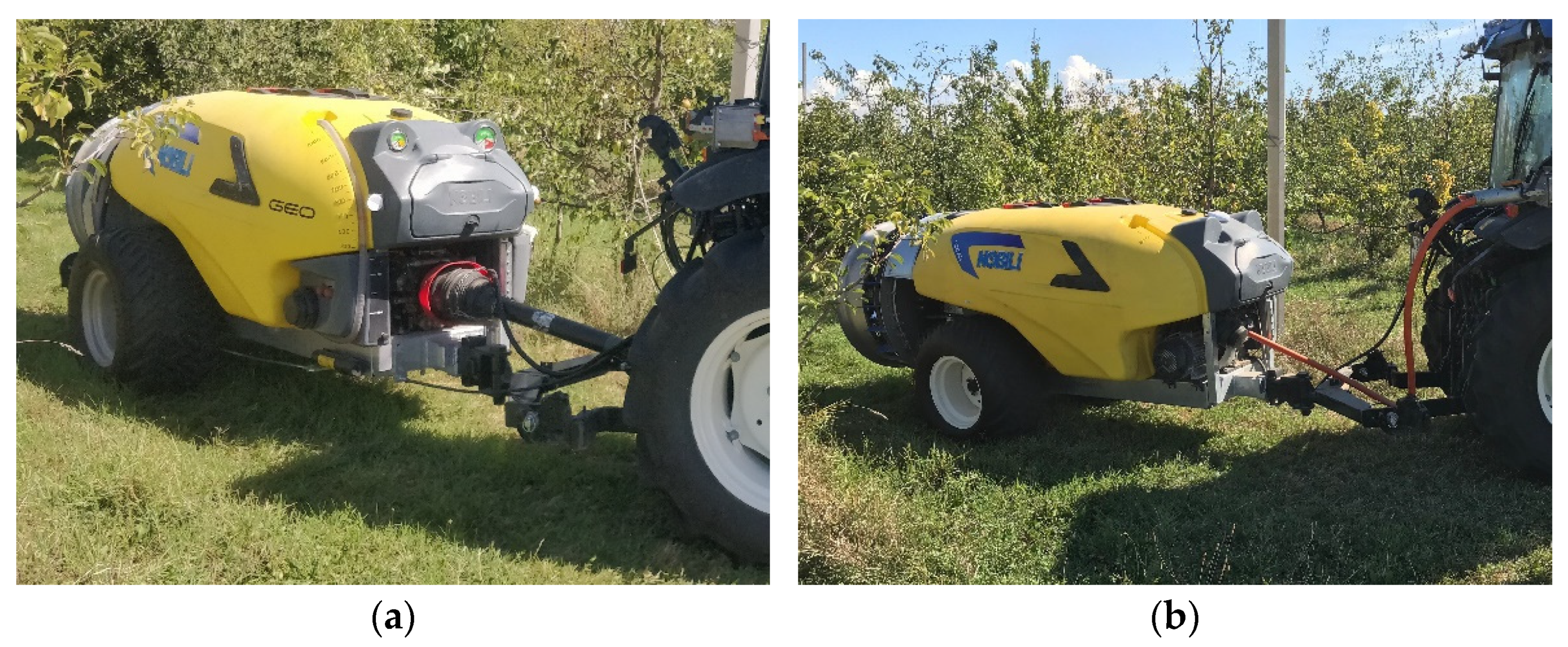
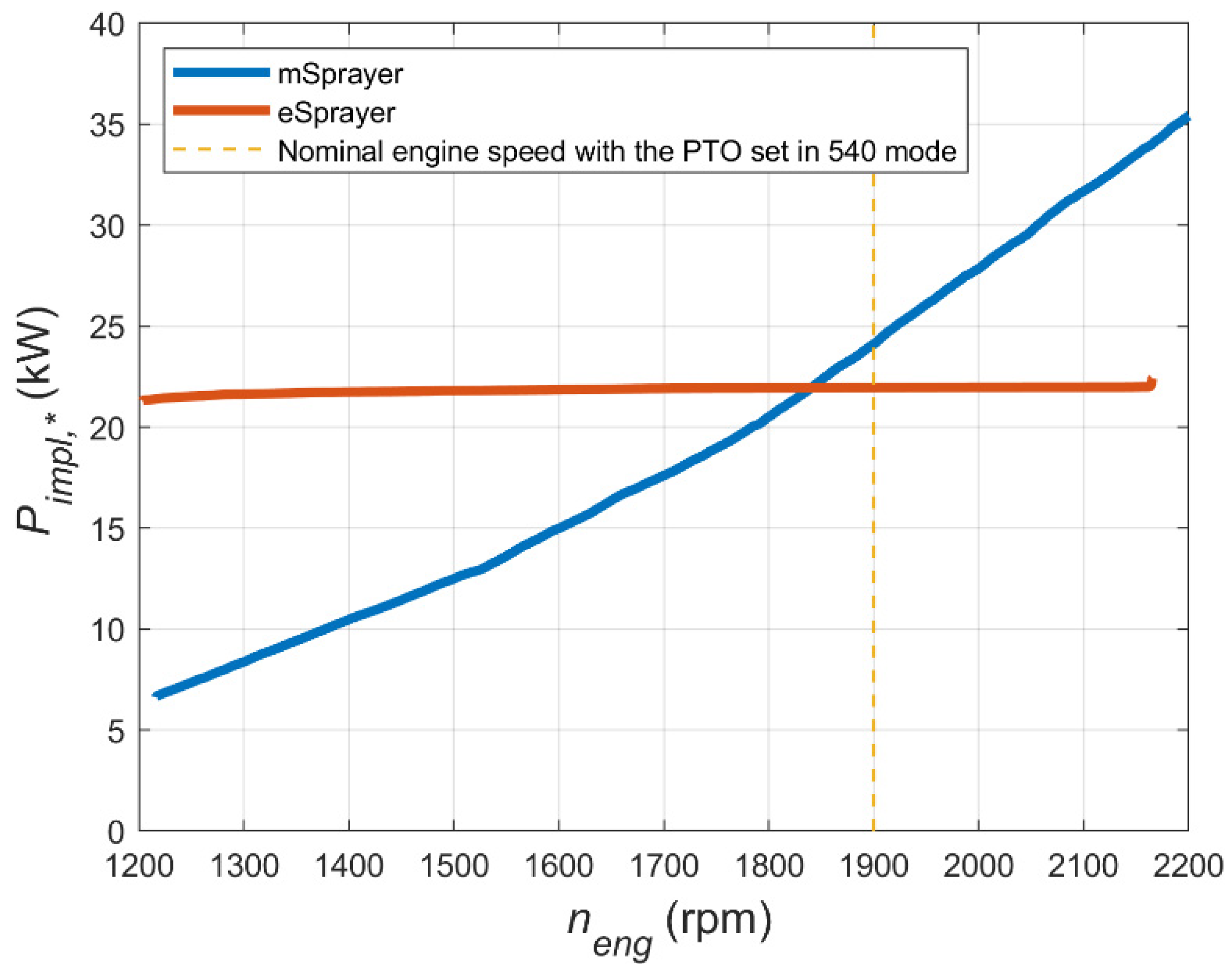


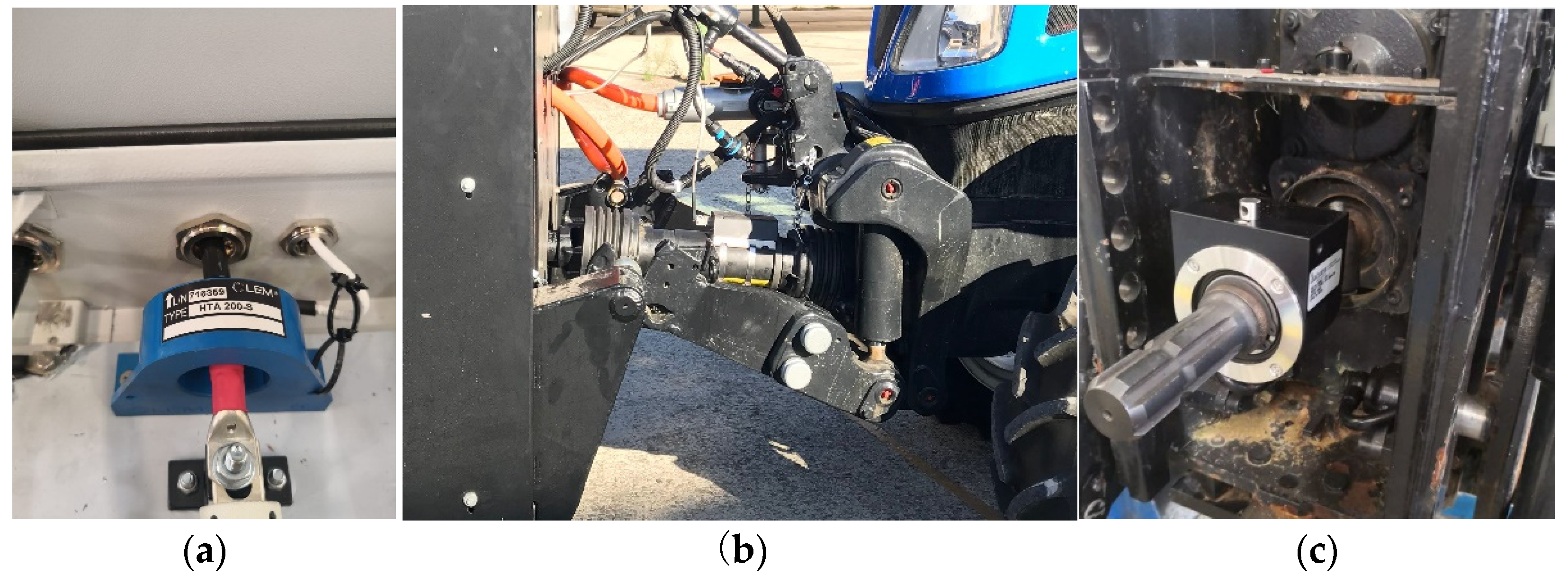
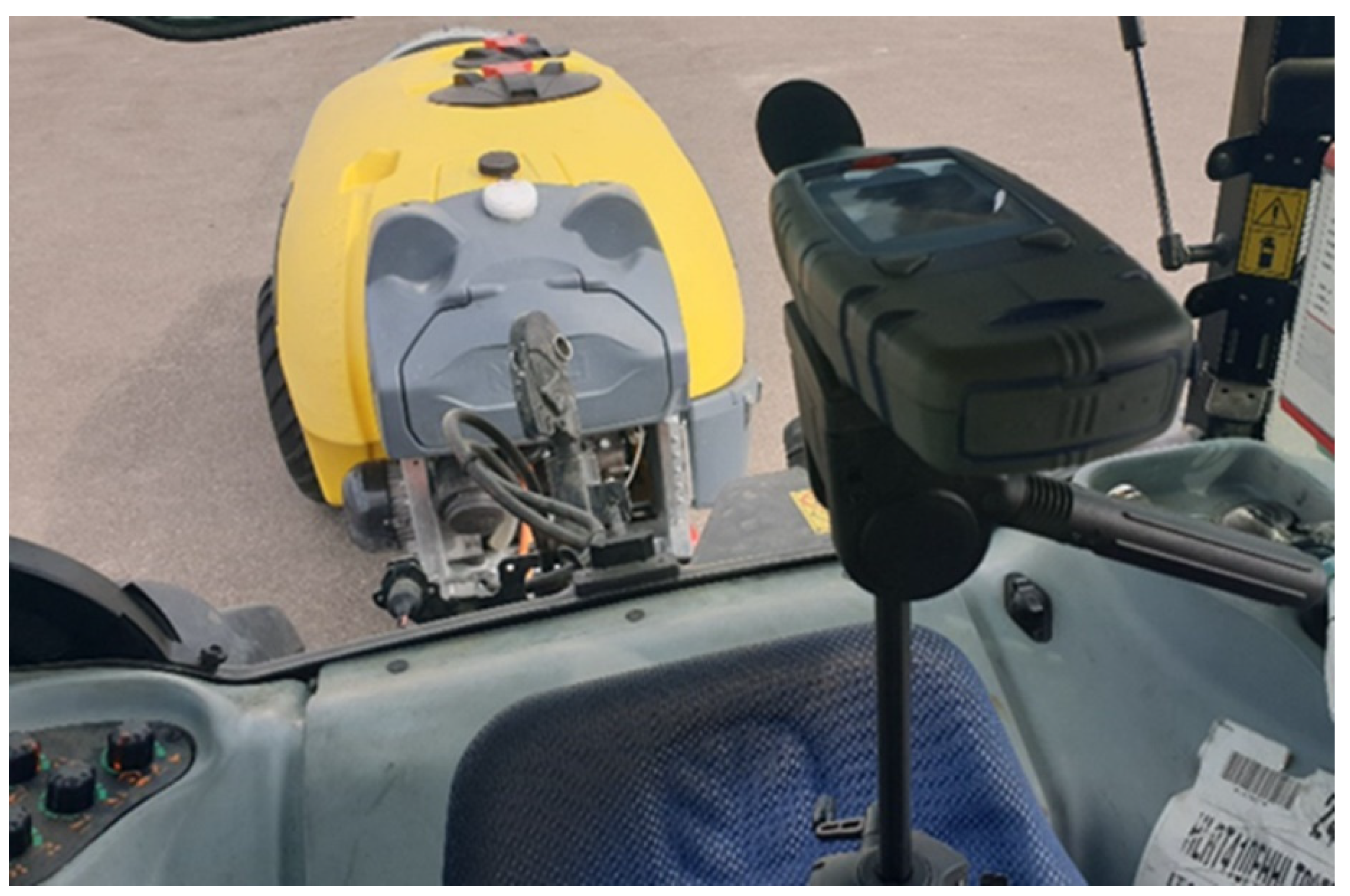

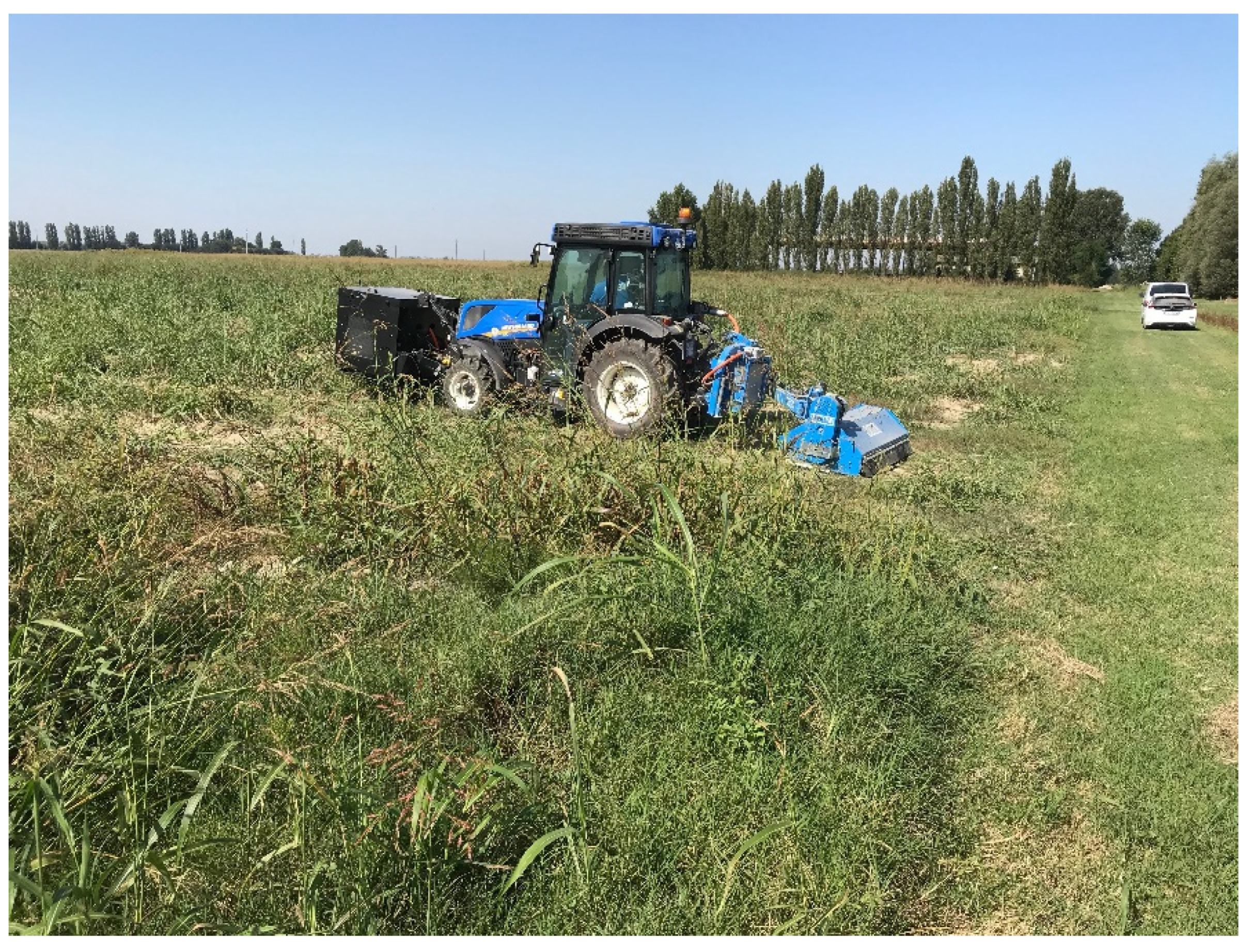
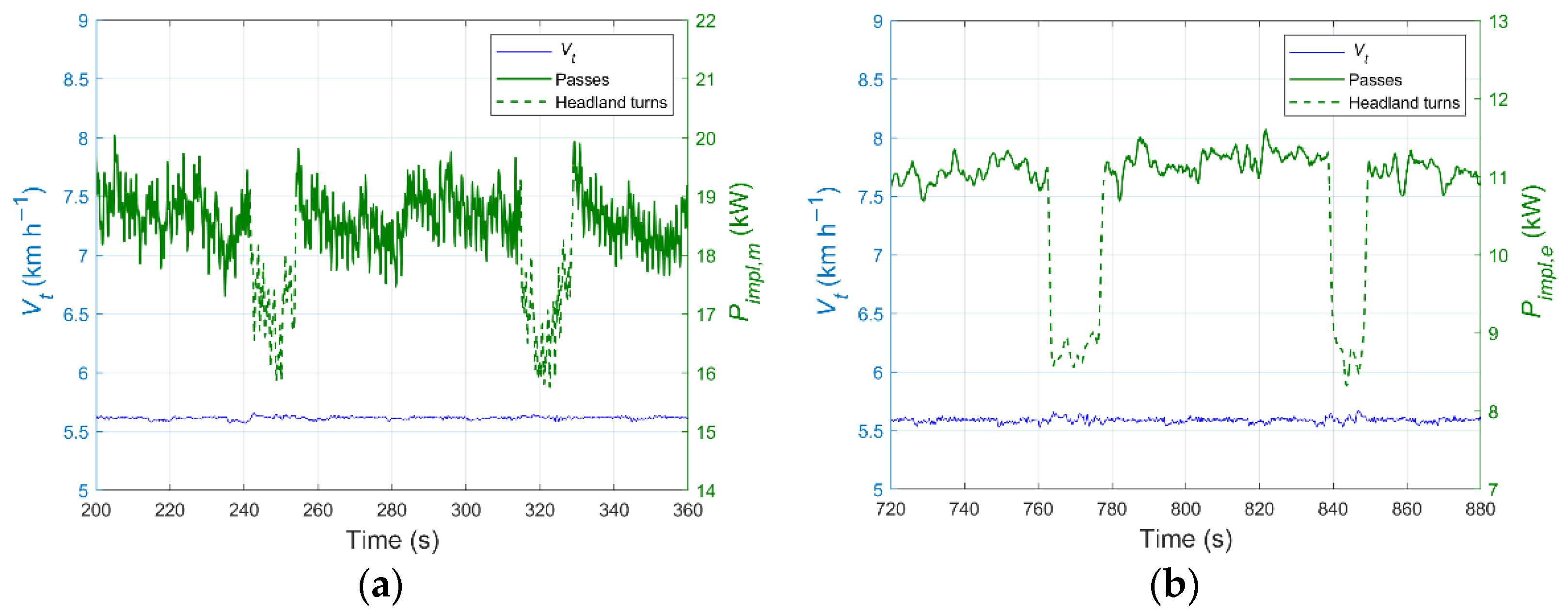
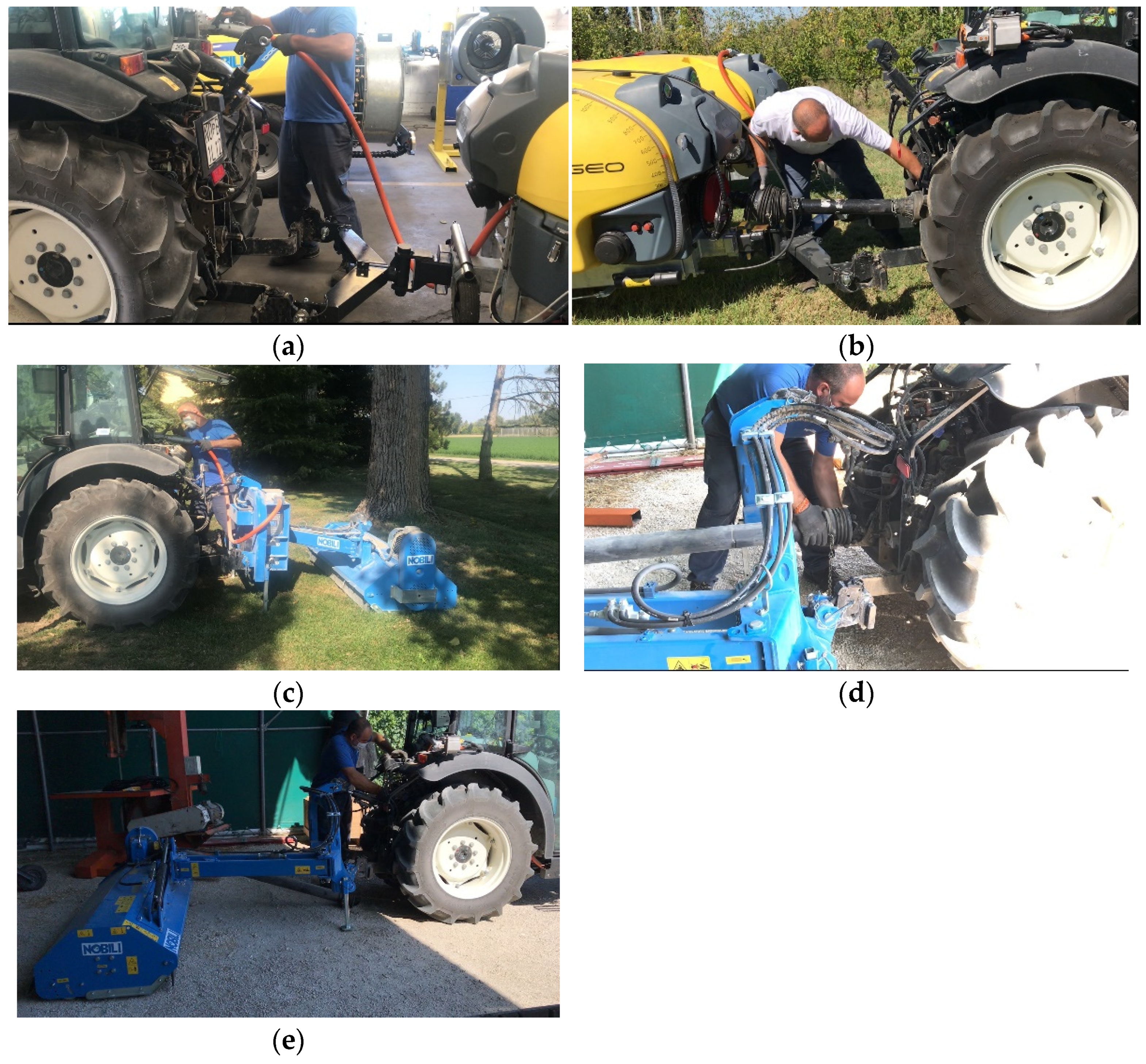
| Specification | Unit | Value |
|---|---|---|
| Nominal engine power | (kW) | 79 @ 2300 rpm |
| Max torque | (Nm) | 444 @ 1500 rpm |
| Unballasted mass | (kg) | 3000 |
| Wheelbase | (mm) | 2180 |
| Front/rear track | (mm) | 910/950 |
| Transmission | (−) | Forward gears: 44 Rearward gears 16 |
| Front PTO nominal speed | (rpm) | 1000 |
| Front PTO transmission ratio | (−) | 1.92 |
| Front PTO nominal speed | (rpm) | 540 |
| Rear PTO transmission ratio in standard mode | (−) | 3.50 |
| Rear PTO transmission ratio in economy mode | (−) | 2.84 |
| Specification | Unit | Value |
|---|---|---|
| Dimensions (Length × Width × Heigth) | (mm) | 1160 × 1140 × 1180 |
| Electric motor type | (−) | Brushless permanent magnet, axial flux |
| Mass | (kg) | 500 |
| Linkage category | (−) | 2nd and 3rd |
| Tractor PTO speed mode | (−) | PTO 1000 |
| Cooling system typology | (−) | Liquid-cooled (water/glycol) |
| Output voltage range | (V) | 600–800 |
| Maximum generated power | (kW) | 50 @ 700V |
| Specification | Unit | mSprayer | eSprayer |
|---|---|---|---|
| Model | (−) | Nobili GEO G2 | Nobili E-SPRAYER |
| Mass (empty tank and without cardan shaft) | (kg) | 700 | 780 |
| Tank capacity | (L) | 1000 | 1000 |
| Fan diameter | (mm) | 900 | 900 |
| Blade model | (−) | Nobili 90 Super | Nobili HF95 |
| Requested PTO nominal speed | (rpm) | 540 | (−) |
| PTO-sprayer fan transmission ratio | (−) | Gear 1: 2.41 Gear 2: 3.33 | (−) |
| Nominal fan speed () | (rpm) | Gear 1:1300 with PTO running at 540 rpm Gear 2:1800 with PTO running at 540 rpm | From 1300 to 1800 |
| Pump pressure range | (MPa) | 0–5 | 0–5 |
| Horizontal spray range | (m) | 4–14 | 4–16 |
| Vertical spray range | (m) | 2–10 | 2–10 |
| Electric motor type | (−) | (−) | Permanent magnet synchronous motor |
| Power drive | (−) | Cardan shaft | AEF high-voltage power interface |
| Maximum power demand | (kW) | (−) | 30 |
| Specification | Unit | mMulcher | eMulcher |
|---|---|---|---|
| Model | (−) | Nobili TB16 | Nobili E-MULCHER |
| Mass (without cardan shaft) | (kg) | 480 | 560 |
| Working width | (mm) | 1600 | 1600 |
| Rotor diameter | (mm) | 374 | 374 |
| Requested PTO nominal speed | (rpm) | 540 | (−) |
| Rotor nominal speed () | (rpm) | 2220 | 2220 |
| Blades number | (−) | 48 | 48 |
| Electric motor type | (−) | (−) | Reluctance synchronous motor |
| Power drive | (−) | Cardan shaft | AEF high-voltage power interface |
| Electric motor maximum power | (kW) | (−) | 18 |
| Name | SPN | PNG | Definition | Id. | Unit |
|---|---|---|---|---|---|
| Engine speed | 190 | 61444 | Revolution speed of the engine crankshaft. | rpm | |
| Engine reference torque | 544 | 65251 | Peak torque used as a reference value for all indicated engine torque parameters. | Nm | |
| Actual engine percent torque | 513 | 61444 | Engine torque as a per cent of reference engine torque; the value includes the torque developed in the cylinders required to overcome friction. | (−) | |
| Nominal friction percent torque | 514 | 5398 | Torque contribution of frictional and thermodynamic losses of the engine itself, pumping torque loss and the losses of fuel, oil, and cooling pumps. | (−) | |
| Engine fuel rate | 183 | 65266 | Amount of fuel consumed per unit of time. | L h−1 |
| Operation | Unit | mSprayer | eSprayer | mMulcher | eMulcher |
|---|---|---|---|---|---|
| Mounting time | (min:s) | 3:40 (0:09) | 2:20 (0:05) | 5:10 (0:10) | 4:20 (0:07) |
| Dismounting time | (min:s) | 1:45 (0:05) | 2:10 (0:06) | 2:50 (0:04) | 2:40 (0:08) |
| Parameter | Unit | eSprayer | mSprayer with 540E | mSprayer with 540 |
|---|---|---|---|---|
| Engine speed () | (rpm) | 1300 | 1500 | 1900 |
| Background noise | (dBA) | 76.8 | 78.0 | 83.0 |
| Sound pressure level with the sprayer fan activated | (dBA) | 85.3 | 92.7 | 93.4 |
| Background noise correction () | (dB) | 0.65 | 0.13 | 0.41 |
| Sound pressure level () | (dBA) | 84.7 | 92.6 | 93.0 |
| Parameter | Unit | eSprayer | mSprayer with 540E | mSprayer with 540 |
|---|---|---|---|---|
| Engine speed () | (rpm) | 1300 | 1500 | 1900 |
| Background noise | (dBA) | 76.8 | 78.0 | 83.0 |
| Sound pressure level with the sprayer fan activated | (dBA) | 90.3 | 96.4 | 96.6 |
| Background noise correction () | (dB) | 0.18 | 0.06 | 0.18 |
| Sound pressure level () | (dBA) | 85.1 | 96.4 | 96.4 |
| Parameter | Unit | eMulcher | mMulcher with 540E | mMulcher with 540 |
|---|---|---|---|---|
| Engine speed () | (rpm) | 1300 | 1500 | 1900 |
| Background noise | (dBA) | 76.8 | 78.0 | 83.0 |
| Sound pressure level with the sprayer fan activated | (dBA) | 88.9 | 93.1 | 94.0 |
| Background noise correction () | (dB) | 0.27 | 0.14 | 0.36 |
| Sound pressure level () | (dBA) | 88.6 | 93.1 | 93.6 |
| Parameter | Unit | eSprayer | mSprayer with 540E | mSprayer with 540 |
|---|---|---|---|---|
| Engine Speed () | (rpm) | 1315 (7.4) | 1588 (3.6) | 1909 (4.8) |
| Tractor speed () | (km h−1) | 5.59 (0.02) | 5.62 (0.01) | 5.42 (0.20) |
| Engine power () | (kW) | 24.9 (1.42) | 32.5 (1.12) | 34.9 (1.81) |
| e-Source input power () | (kW) | 13.1 (0.51) | (−) | (−) |
| Implement absorbed power () | (kW) | 11.1 (0.18) | 18.5 (1.26) | 16.6 (1.36) |
| Engine fuel rate () | (L h−1) | 6.6 (0.33) | 9.0 (0.26) | 9.9 (0.42) |
| Parameter | Unit | eSprayer | mSprayer with 540E | mSprayer with 540 |
|---|---|---|---|---|
| Engine Speed () | (rpm) | 1305 (25.5) | 1518 (5.8) | 1890 (4.4) |
| Tractor speed () | (km h−1) | 5.55 (0.11) | 5.37 (0.02) | 5.42 (0.01) |
| Engine power () | (kW) | 35.6 (2.37) | 40.1 (1.68) | 41.6 (1.77) |
| e-Source input power () | (kW) | 23.6 (0.58) | (−) | (−) |
| Implement absorbed power () | (kW) | 21.6 (0.34) | 24.6 (0.97) | 24.1 (1.33) |
| Engine fuel rate () | (L h−1) | 9.2 (0.57) | 10.8 (0.38) | 11.7 (0.49) |
| Parameter | Unit | eMulcher | mMulcher with 540E | mMulcher with 540 |
|---|---|---|---|---|
| Engine Speed () | (rpm) | 1306 (6.0) | 1568 (7.0) | 1897 (6.9) |
| Tractor speed () | (km h−1) | 3.12 (0.03) | 3.06 (0.01) | 3.08 (0.01) |
| Engine power () | (kW) | 16.2 (1.54) | 18 (2.01) | 20.7 (2.63) |
| e-Source input power () | (kW) | 3.3 (0.56) | (−) | (−) |
| Implement absorbed power () | (kW) | 3.0 (0.67) | 4.7 (1.42) | 4.3 (1.58) |
| Engine fuel rate () | (L h−1) | 4.7 (0.34) | 5.6 (0.44) | 6.7 (0.54) |
| Parameter | Unit | eSprayer | mSprayer with 540E | mSprayer with 540 |
|---|---|---|---|---|
| Field capacity () | (ha h−1) | 2.29 | 2.3 | 2.22 |
| Fuel consumption per hectare () | (L ha−1) | 2.9 | 3.9 | 4.4 |
| CO2 emission per hectare () | (kg ha−1) | 7.6 | 10.4 | 11.8 |
| Yearly time spent () | (h year−1) | 859 | 863 | 833 |
| Yearly diesel consumption () | (L year−1) | 1088 | 1463 | 1650 |
| Yearly diesel cost () | (€ year−1) | 979 | 1316 | 1485 |
| CO2 emitted per year () | (kg year−1) | 2850 | 3900 | 4425 |
| Parameter | Unit | eSprayer | mSprayer with 540E | mSprayer with 540 |
|---|---|---|---|---|
| Field capacity () | (ha h−1) | 2.27 | 2.2 | 2.22 |
| Fuel consumption per hectare () | (L ha−1) | 4.1 | 4.9 | 5.3 |
| CO2 emission per hectare () | (kg ha−1) | 10.8 | 13.0 | 14.0 |
| Yearly time spent () | (h year−1) | 851 | 825 | 833 |
| Yearly diesel consumption () | (L year−1) | 1538 | 1838 | 1988 |
| Yearly diesel cost () | (€ year−1) | 1384 | 1654 | 1789 |
| CO2 emitted per year () | (kg year−1) | 4050 | 4875 | 5250 |
| Parameter | Unit | eMulcher | mMulcher with 540E | mMulcher with 540 |
|---|---|---|---|---|
| Field capacity () | (ha h−1) | 0.5 | 0.49 | 0.49 |
| Fuel consumption per hectare () | (L ha−1) | 9.4 | 11.7 | 13.7 |
| CO2 emission per hectare () | (kg ha−1) | 24.8 | 30.9 | 36.4 |
| Yearly time spent () | (h year−1) | 87 | 85 | 85 |
| Yearly diesel consumption () | (L year−1) | 1636 | 2036 | 2384 |
| Yearly diesel cost () | (€ year−1) | 1472 | 1832 | 2145 |
| CO2 emitted per year () | (kg year−1) | 4315 | 5377 | 6334 |
Publisher’s Note: MDPI stays neutral with regard to jurisdictional claims in published maps and institutional affiliations. |
© 2021 by the authors. Licensee MDPI, Basel, Switzerland. This article is an open access article distributed under the terms and conditions of the Creative Commons Attribution (CC BY) license (https://creativecommons.org/licenses/by/4.0/).
Share and Cite
Varani, M.; Mattetti, M.; Molari, G. Performance Evaluation of Electrically Driven Agricultural Implements Powered by an External Generator. Agronomy 2021, 11, 1447. https://doi.org/10.3390/agronomy11081447
Varani M, Mattetti M, Molari G. Performance Evaluation of Electrically Driven Agricultural Implements Powered by an External Generator. Agronomy. 2021; 11(8):1447. https://doi.org/10.3390/agronomy11081447
Chicago/Turabian StyleVarani, Massimiliano, Michele Mattetti, and Giovanni Molari. 2021. "Performance Evaluation of Electrically Driven Agricultural Implements Powered by an External Generator" Agronomy 11, no. 8: 1447. https://doi.org/10.3390/agronomy11081447
APA StyleVarani, M., Mattetti, M., & Molari, G. (2021). Performance Evaluation of Electrically Driven Agricultural Implements Powered by an External Generator. Agronomy, 11(8), 1447. https://doi.org/10.3390/agronomy11081447







